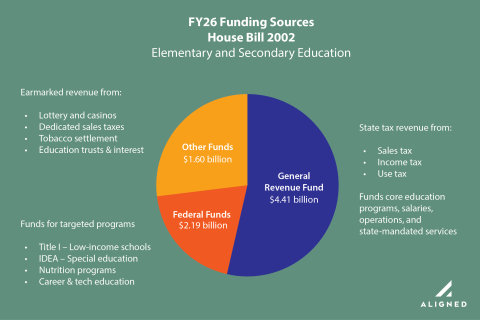How Missouri Funds Public Schools

This week, the Missouri House Budget Committee approved HB 2, allocating $8.2 billion for elementary and secondary education in the upcoming fiscal year. The committee's version of the bill also diverges from several of Governor Mike Kehoe's early childhood priorities. Specifically, it excludes the Governor's proposed increase to the child care subsidy program, which would have raised funding from $259.8 million to $366.5 million to support prospective payments to providers based on enrollment; leaves out a $17.9 million increase for the First Steps program, which provides early intervention services for infants and toddlers with developmental delays; and does not include the Governor’s proposed $20.8 million increase for Early Childhood Special Education.
These decisions will likely surface in floor debate next week as lawmakers weigh Missouri's long-term investment in its youngest learners. Additionally, the bill faces an uncertain environment in the state Senate, where Appropriations Committee Chairman Senator Lincoln Hough (R-Springfield) has vowed to fully fund the ongoing implementation of SB 727, passed in 2024, which would require a significant increase in funding levels compared to the House Committee version approved this week.
This, That, and the Other
Missouri's education funding primarily derives from three key sources:
- General Revenue: Funds generated from sales, income, and use taxes; this category rises and falls with the economy. FY26 = $4.41 billion
- Federal Funds: Funds sent to states for specific programs such as Title I, IDEA, and child nutrition. FY26 = $1.60 billion
- Other Funds: Funds received from gaming, lottery sales, tobacco taxes, and court settlements—often earmarked for education but less visible in public debate. FY26 = $2.19 billion
What’s in the "Other" bucket?
HB 2 includes $2.19 billion from “Other Funds” to support elementary and secondary education. Roughly $813 million comes from gaming and lottery revenue, routed through trust funds like the Classroom Trust Fund and from a dedicated 1% sales tax deposited into the School District Trust Fund. These sources help fund the Foundation Formula, transportation, special education, and other public school programs.
The remaining $1.38 billion comes from a mix of other dedicated sources—including tobacco settlement funds, endowments and trusts, interest earnings, and state and federal pass-through accounts. These funds are often earmarked for specific uses but receive far less public attention than general revenue or federal dollars.
For a deeper dive into how gaming revenue flows through Missouri and Kansas, check out our October article on gaming revenue.